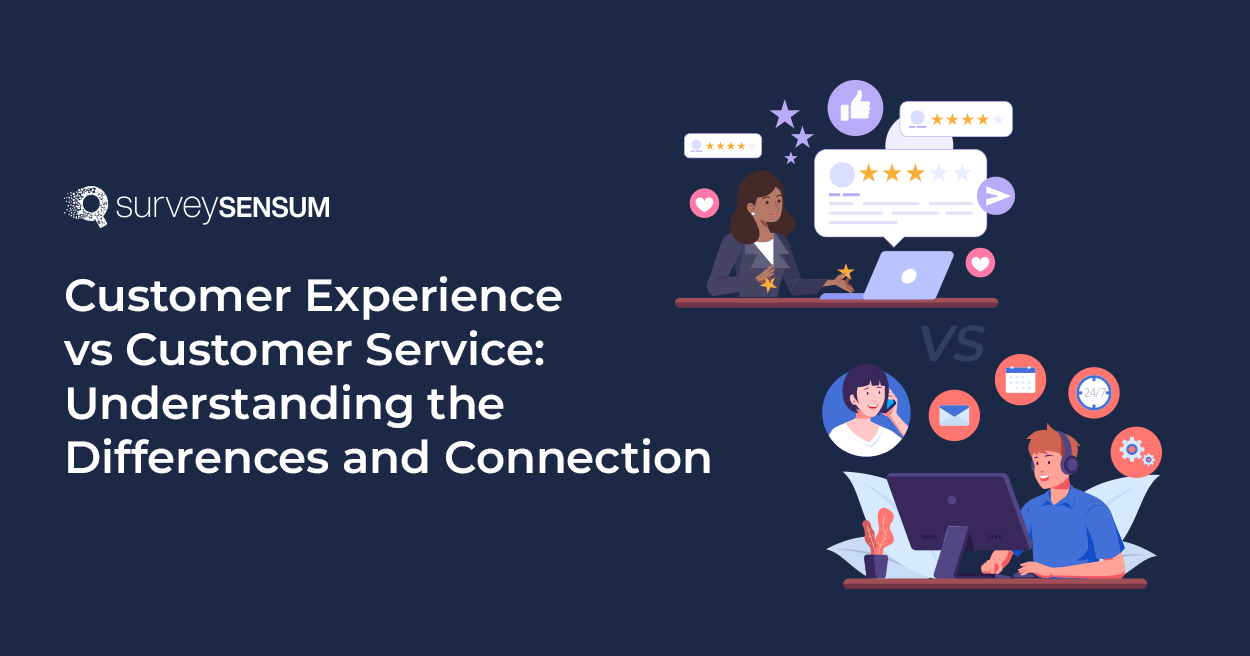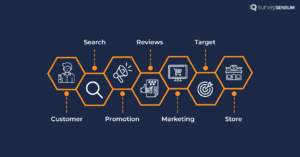9 Ways to Improve NPS Response Rates
Read More

Do you often use ‘customer experience’ and ‘customer service’ interchangeably?
If your answer is yes, then my friend you are doing it wrong.
Because these two terms hold distinct meanings and should not be used interchangeably.
This brings us to the debate of customer experience vs customer service. Understanding the differences between both is vital for your business to thrive in the customer-centered world.
In this blog, we will explore the same. What are customer experience and customer service, how they’re connected, their differences, why do they matter for your business, and how a customer feedback platform can help you ease your work to enhance the overall experience?
So, let us begin this journey of customer experience vs customer service to uncover what keeps customers not just satisfied but genuinely delighted with your brand.
Customer experience is all about the journey your customers take when they interact with your brand or business. It covers every step of the way, starting from the moment they first learn about your product or service.
But, why is it so important?
There are several reasons that signify how crucial CX is:
Now that you know the importance of customer experience, let’s talk about the customer journey.
 A customer journey is the path customers take when interacting with a business – covering everything from discovering a product to deciding to buy and the follow-up interactions.
A customer journey is the path customers take when interacting with a business – covering everything from discovering a product to deciding to buy and the follow-up interactions.For example, in the world of e-commerce, the customer’s journey involves aspects like website usability, product selection, the checkout process, and how effective customer support is.
Now comes a question – How to measure customer experience?
You can gauge the quality of your customer experience by using common metrics like the Net Promoter Score, Customer Satisfaction Score, and Customer Effort Score. These metrics assess how exceptional your customers’ experiences are.
Let’s talk about Customer Service.
Customer service is the support and assistance provided to customers before, during, and after their interaction with a company.
It encompasses a wide range of services, including in-person interactions, phone support through advanced inbound calling software, email correspondence, live chat, self-service options, and assistance through social media platforms like Twitter or Facebook.
But is it really important to customers?
Customer service is crucial for several reasons:
Now you must be thinking about offering great customer service to your customers after knowing its importance, right?
To offer exceptional customer service, ensure:
By excelling in these aspects, businesses can build and maintain positive relationships with customers, leading to success and growth.
With that let’s move ahead to our next section talking about the key differences between customer experience and service.
| Customer Experience | Customer Service |
| Covers the entire customer journey, from start to finish | Deals with specific customer interactions or questions |
| Builds lasting relationships | Resolves issues immediately |
| Involves the entire company, ensuring a consistent journey | Typically managed by a specific department, often the customer support team |
| Metrics like NPS and CSAT provide insights into the overall experience | Metrics focus on response times, issue resolution rates, and interaction quality during specific support requests |
| Everyone in the organization contributes to a proactive approach throughout the journey | Handled by the customer support team, with a reactive focus on issue resolution |
| Proactively anticipates and fulfills customer needs, aiming for a delightful journey | Primarily reactive, responding to customer issues and focusing on solving them |
Let’s dive deeper —
For example, a customer experience team would measure Net Promoter Score and service teams would look at Average Response Time.
These differences highlight that while both CX and customer service are essential for customer satisfaction, they serve distinct roles within the broader framework of a customer-centric approach.
Enhance Your Customer Experience With SurveySensum- Request a Demo
Delivering great customer service directly contributes to positive experiences, provides valuable feedback to enhance CX, and plays a pivotal role in determining customer loyalty. Following are the 3 connections:
When you visit your favorite restaurant, do they offer only food?
No, right?
They also offer their hospitality via helpful and friendly staff also they make a menu according to their customer preferences.
And this service makes your dining experience better, right?
Similarly is the case with your business. When you offer excellent customer service, it means you’re really good at helping and supporting your customers. This directly results in customers having a good time and feeling happy when they interact with your company.
This is how good customer service creates positive customer experiences.
Imagine you’re baking cookies, and someone tastes them and says, “These need more chocolate chips!” That real-time feedback helps you make better cookies, right?
Similarly, customer service isn’t just about solving problems; it’s also a way to gather feedback from customers. This feedback is valuable for you because when customers talk to customer support, they often share what they like about your company’s products or services and vice versa.
This gathered positive customer feedback can be used to make the overall customer experience better. That’s how customer service helps a company figure out how to improve what they offer.
Companies that rank customer service as a top priority are 6 times more likely to surpass their customer retention goals.
When a company provides great customer service, it builds trust and loyalty with its customers. This also increases customer retention leading to growth in your business. On the other hand, if a company provides bad customer service, it pushes customers away. This leads them to look for other companies that treat them better.
Good customer service can keep customers and encourage recommendations, while poor service may drive them away and harm your reputation. This highlights the connection between customer service and customer experience – getting them right can build customer loyalty, and retention, prevent customer churn, and ultimately more profit.
We’ve explored everything about the customer experience and customer service along with their differences and connections. Here’s a quick recap:
And the main difference between them is
And the connection between them is
In simple terms, good service makes customers happy, provides valuable insights for improvement, and keeps them coming back. To enhance your own customer experience and service, consider using SurveySensum. It’s a tool that can help you gather feedback effortlessly and make your customers even happier.
